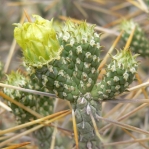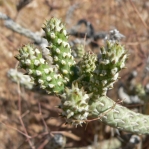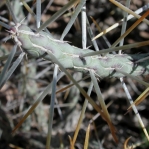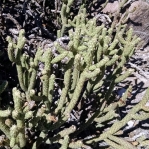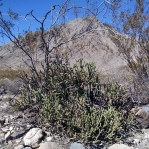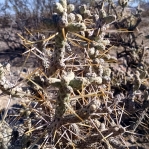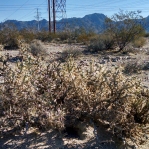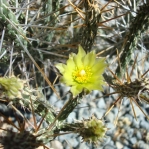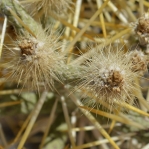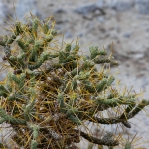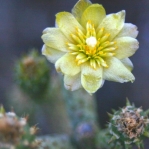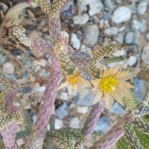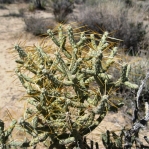Engelmann. 1852. American Journal of Science and Arts, ser. 2, vol. 14 (42): 339.
Herbarium specimen; Herbarium specimen; Herbarium specimen; Herbarium specimen; Herbarium specimen; Herbarium specimen; Herbarium specimen; Herbarium specimen; Herbarium specimen; Drawing (as C. tesselata; Bigelow, J.M, The Botany of the Expedition, 1856, plate XXI)
Original species description
Flora of North America treatment
What is Cylindropuntia ramosissima?
Cylindropuntia ramosissima is a wide-ranging species growing in washes, flats, bajadas, sandy loam soils, desert pavement, and volcanic soils in the Mojave and Sonoran Deserts of California, Nevada, Arizona, northern Baja California, Mexico, and Sonora, Mexico.
Details
C. ramosissima habit ranges from a sprawling, decumbent shrub to a tree-like plant of up to 2 m tall. The tubercules are distinctive in that they are flat with a clear, diamond-shaped outline, hence the common name “diamond cholla”. The areoles have 0 to 1 tan, red-brown, or deep purple spines which age gray. The spine sheaths are baggy and often yellow-tipped. The narrow stems are firmly attached and range from 2 to 8 cm long by 0.4 to 1 cm wide. The stems are generally green in good conditions to purple-brown in harsher environments. The flowers range from pale yellow to rosy-pink with pale green filaments and white, rose, or light green styles. The fruits are dry and very spiny. C. ramosissima is mainly diploid (2n = 22), but several tetraploid (2n = 44) individuals have been found, particularly in sandy habitats.
C. ramosissima does not appear to hybridize as readily as most chollas. A single hybrid between C. ramosissima and C. leptocaulis has been found adjacent to Jan Emming’s D:F Ranch in the Hualapai Mountains of northwestern Arizona. A single hybrid between C. ramosissima and C. echinocarpa was salvaged by Marc Baker and Michelle Cloud-Hughes from a solar site in southern Nevada.

